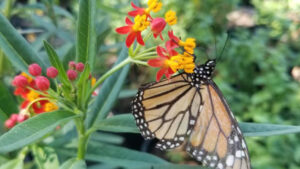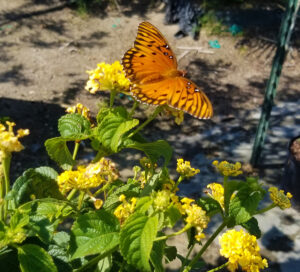By: Anna Stubbendick, FCHP
Happy Earth Day everyone! As we celebrate our planet this coming weekend and take action to protect it, let’s talk about one fun and easy way you can contribute to a healthier ecosystem: creating a butterfly garden in your backyard.
According to the University of Florida’s Institute of Food and Agricultural Sciences (IFAS), butterflies and moths are among the most recognizable and important insects in Florida landscapes. They are also vital pollinators and serve as valuable indicators of ecosystem health. Unfortunately, habitat loss, pesticide use, and climate change are causing declines in butterfly populations across the country. By creating a butterfly garden, you can help combat these threats and contribute to the survival of these fascinating insects.
How to Create Your Butterfly Garden
Creating a butterfly garden is a simple and enjoyable project that anyone can do, and is a great family acitivity! To get started, choose a location in your yard that is sheltered from wind and rain and receives plenty of sunlight. Butterflies also need a source of water, so consider adding a birdbath or shallow dish filled with water to your garden.

Tropical Milkweed (Asclepias curassavica) is a popular plant for butterfly gardens in central Florida. This milkweed species is native to Central and South America but has naturalized in Florida and is a critical food source for Monarch butterflies. ©Photo by Anna Stubbendick, Canterbury Farms
The next step is to choose the right plants for your butterfly garden. Butterflies prefer plants that have a lot of nectar, as this is the primary food source for adult butterflies. Some of the best plants for butterflies include milkweed, which is a host plant for Monarch butterflies, and coneflower, which is popular with many species of butterflies. Canterbury Farms Nursery & Garden Center has Tropical Milkeed (Asclepias curassavica) in stock right now. Other excellent plants for butterfly gardens include butterfly bush, black-eyed Susan, lantana, and zinnias. Make sure to choose plants that bloom at different times throughout the year, so the butterflies have a constant supply of nectar.
When creating a butterfly garden, it’s important to avoid using pesticides, as many of these chemicals are toxic to butterflies and other pollinators. Instead, consider using natural methods of pest control, such as companion planting, where you plant certain plants together that help to repel pests. The use of natural predators such as ladybugs is also a safe and effective way of managing some insect pest populations like aphids and whiteflies. Canterbury Farms Nursery & Garden Center now has live ladybugs available for sale; they come in a 1500ct package for $14.95. By avoiding pesticides, you’re not only protecting the butterflies in your garden but also contributing to a healthier ecosystem.
Every garden can make a difference.
Pollinator.org, a website dedicated to promoting the health of pollinators, including butterflies, notes that “every little bit helps, and every garden can make a difference.” By creating a butterfly garden, you are not only providing a home for these beautiful insects but also supporting the health of your local ecosystem. This small step can make a big difference in the overall health and survival of butterfly populations.

Lantana is another great choice for pollinator gardens. The non-native Lantana camara is the most common species found at most nurseries and garden centers, including Canterbury Farms. ©Photo by Anna Stubbendick, Canterbury Farms
In addition to benefiting the environment, creating a butterfly garden is also a fun and rewarding project for you and your family. It’s a great way to connect with nature, learn about the importance of pollinators like butterflies, and get some fresh air and exercise. Plus, it adds beauty to your outdoor space and provides a peaceful retreat where you can relax and enjoy the sights and sounds of nature.
As we celebrate Earth Day, let’s take action to protect our planet by creating butterfly gardens and supporting the health of our local ecosystems. According to Pollinator.org, “By creating a pollinator-friendly garden, you are helping to ensure the survival of these important insects, as well as the preservation of the local ecosystem.” So, grab your gardening gloves, get outside, and create a butterfly garden. It’s a fun and easy way to make a difference and contribute to a healthier planet. Happy Earth Day!
For more information, check out these helpful links:
Butterfly & Hummingbird-Friendly Plants
UF/IFAS Gardening Solutions: Gardening for Butterflies
Pollinator Partnership Regional Planting Guide
